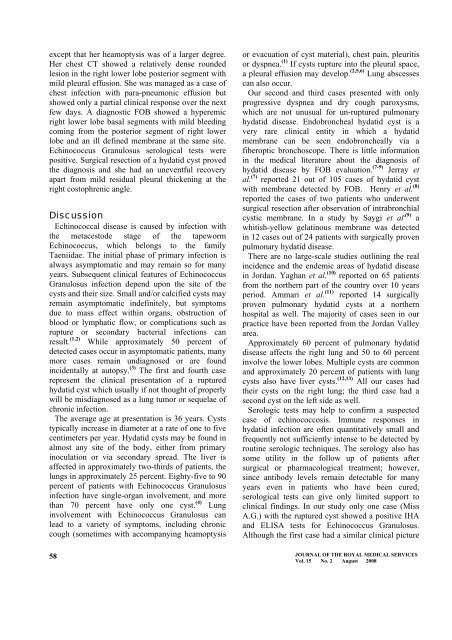H. El-Khushman, A. Sharara, J. Momani, A. Al-Suleihat, M. Al ...
H. El-Khushman, A. Sharara, J. Momani, A. Al-Suleihat, M. Al ...
H. El-Khushman, A. Sharara, J. Momani, A. Al-Suleihat, M. Al ...
Create successful ePaper yourself
Turn your PDF publications into a flip-book with our unique Google optimized e-Paper software.
except that her heamoptysis was of a larger degree.<br />
Her chest CT showed a relatively dense rounded<br />
lesion in the right lower lobe posterior segment with<br />
mild pleural effusion. She was managed as a case of<br />
chest infection with para-pneumonic effusion but<br />
showed only a partial clinical response over the next<br />
few days. A diagnostic FOB showed a hyperemic<br />
right lower lobe basal segments with mild bleeding<br />
coming from the posterior segment of right lower<br />
lobe and an ill defined membrane at the same site.<br />
Echinococcus Granulosus serological tests were<br />
positive. Surgical resection of a hydatid cyst proved<br />
the diagnosis and she had an uneventful recovery<br />
apart from mild residual pleural thickening at the<br />
right costophrenic angle.<br />
Discussion<br />
Echinococcal disease is caused by infection with<br />
the metacestode stage of the tapeworm<br />
Echinococcus, which belongs to the family<br />
Taeniidae. The initial phase of primary infection is<br />
always asymptomatic and may remain so for many<br />
years. Subsequent clinical features of Echinococcus<br />
Granulosus infection depend upon the site of the<br />
cysts and their size. Small and/or calcified cysts may<br />
remain asymptomatic indefinitely, but symptoms<br />
due to mass effect within organs, obstruction of<br />
blood or lymphatic flow, or complications such as<br />
rupture or secondary bacterial infections can<br />
result. (1,2) While approximately 50 percent of<br />
detected cases occur in asymptomatic patients, many<br />
more cases remain undiagnosed or are found<br />
incidentally at autopsy. (3) The first and fourth case<br />
represent the clinical presentation of a ruptured<br />
hydatid cyst which usually if not thought of properly<br />
will be misdiagnosed as a lung tumor or sequelae of<br />
chronic infection.<br />
The average age at presentation is 36 years. Cysts<br />
typically increase in diameter at a rate of one to five<br />
centimeters per year. Hydatid cysts may be found in<br />
almost any site of the body, either from primary<br />
inoculation or via secondary spread. The liver is<br />
affected in approximately two-thirds of patients, the<br />
lungs in approximately 25 percent. Eighty-five to 90<br />
percent of patients with Echinococcus Granulosus<br />
infection have single-organ involvement, and more<br />
than 70 percent have only one cyst. (4) Lung<br />
involvement with Echinococcus Granulosus can<br />
lead to a variety of symptoms, including chronic<br />
cough (sometimes with accompanying heamoptysis<br />
or evacuation of cyst material), chest pain, pleuritis<br />
or dyspnea. (1) If cysts rupture into the pleural space,<br />
a pleural effusion may develop. (2,5,6) Lung abscesses<br />
can also occur.<br />
Our second and third cases presented with only<br />
progressive dyspnea and dry cough paroxysms,<br />
which are not unusual for un-ruptured pulmonary<br />
hydatid disease. Endobroncheal hydatid cyst is a<br />
very rare clinical entity in which a hydatid<br />
membrane can be seen endobroncheally via a<br />
fiberoptic bronchoscope. There is little information<br />
in the medical literature about the diagnosis of<br />
hydatid disease by FOB evaluation. (7-9) Jerray et<br />
al. (7) reported 21 out of 105 cases of hydatid cyst<br />
with membrane detected by FOB. Henry et al. (8)<br />
reported the cases of two patients who underwent<br />
surgical resection after observation of intrabronchial<br />
cystic membrane. In a study by Saygi et al .(9) a<br />
whitish-yellow gelatinous membrane was detected<br />
in 12 cases out of 24 patients with surgically proven<br />
pulmonary hydatid disease.<br />
There are no large-scale studies outlining the real<br />
incidence and the endemic areas of hydatid disease<br />
in Jordan. Yaghan et al. (10) reported on 65 patients<br />
from the northern part of the country over 10 years<br />
period. Ammari et al. (11) reported 14 surgically<br />
proven pulmonary hydatid cysts at a northern<br />
hospital as well. The majority of cases seen in our<br />
practice have been reported from the Jordan Valley<br />
area.<br />
Approximately 60 percent of pulmonary hydatid<br />
disease affects the right lung and 50 to 60 percent<br />
involve the lower lobes. Multiple cysts are common<br />
and approximately 20 percent of patients with lung<br />
cysts also have liver cysts. (12,13) <strong>Al</strong>l our cases had<br />
their cysts on the right lung; the third case had a<br />
second cyst on the left side as well.<br />
Serologic tests may help to confirm a suspected<br />
case of echinococcosis. Immune responses in<br />
hydatid infection are often quantitatively small and<br />
frequently not sufficiently intense to be detected by<br />
routine serologic techniques. The serology also has<br />
some utility in the follow up of patients after<br />
surgical or pharmacological treatment; however,<br />
since antibody levels remain detectable for many<br />
years even in patients who have been cured,<br />
serological tests can give only limited support to<br />
clinical findings. In our study only one case (Miss<br />
A.G.) with the ruptured cyst showed a positive IHA<br />
and ELISA tests for Echinococcus Granulosus.<br />
<strong>Al</strong>though the first case had a similar clinical picture<br />
58<br />
JOURNAL OF THE ROYAL MEDICAL SERVICES<br />
Vol. 15 No. 2 August 2008
















